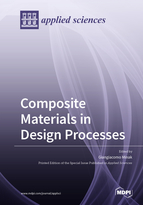Composite Materials in Design Processes
A special issue of Applied Sciences (ISSN 2076-3417). This special issue belongs to the section "Materials Science and Engineering".
Deadline for manuscript submissions: closed (31 July 2020) | Viewed by 35201
Special Issue Editor
Interests: structural design; composite materials; smart materials; fluid–structure interaction; mechanical behavior of materials; design for additive manufacturing
Special Issues, Collections and Topics in MDPI journals
Special Issue Information
Dear Colleagues,
the use of composite materials in the design process allows tailoring the mechanical properties of the components, with the aim of reducing the overall weight. The possible combinations of matrix, reinforcements and technologies, on the one hand provide many more options to the designer, and on the other hand widen the fields that need to be investigated to obtain all the information requested for a safe design.
This Special Issue of Applied Sciences, “Composite materials in design processes”, has the aim of collecting recent advances in design methods for components made of composites and the properties of composite materials (at laminate level or using a multi-scale approach).
In particular paper are welcome on the following topics:
- Case studies
- Design criteria
- Numerical modelling of components made by composites
- Experimental validation at a component level
Design for:
- Resistance to the fatigue loading of laminates
- Resistance to the impact loading and slamming of laminates and sandwiches
- Resistance to high temperatures
Design of:
- Hybrid laminates
- Bio-composites
- Recycled composites
- Self-reinforced composites
- Functional composite materials (including nano-modified materials)
- Self-sensing laminates
- Self-healing laminates
- Laminates with morphing capabilities
- Joints of laminates and sandwiches
Prof. Dr. Giangiacomo Minak
Guest Editor
Manuscript Submission Information
Manuscripts should be submitted online at www.mdpi.com by registering and logging in to this website. Once you are registered, click here to go to the submission form. Manuscripts can be submitted until the deadline. All submissions that pass pre-check are peer-reviewed. Accepted papers will be published continuously in the journal (as soon as accepted) and will be listed together on the special issue website. Research articles, review articles as well as short communications are invited. For planned papers, a title and short abstract (about 100 words) can be sent to the Editorial Office for announcement on this website.
Submitted manuscripts should not have been published previously, nor be under consideration for publication elsewhere (except conference proceedings papers). All manuscripts are thoroughly refereed through a single-blind peer-review process. A guide for authors and other relevant information for submission of manuscripts is available on the Instructions for Authors page. Applied Sciences is an international peer-reviewed open access semimonthly journal published by MDPI.
Please visit the Instructions for Authors page before submitting a manuscript. The Article Processing Charge (APC) for publication in this open access journal is 2400 CHF (Swiss Francs). Submitted papers should be well formatted and use good English. Authors may use MDPI's English editing service prior to publication or during author revisions.
Keywords
- Composite Materials
- Stiffness
- Strength
- Fatigue Resistance
- Impact Loading
- Buckling
- Design for X
- Delamination
- Creep
- Joints






